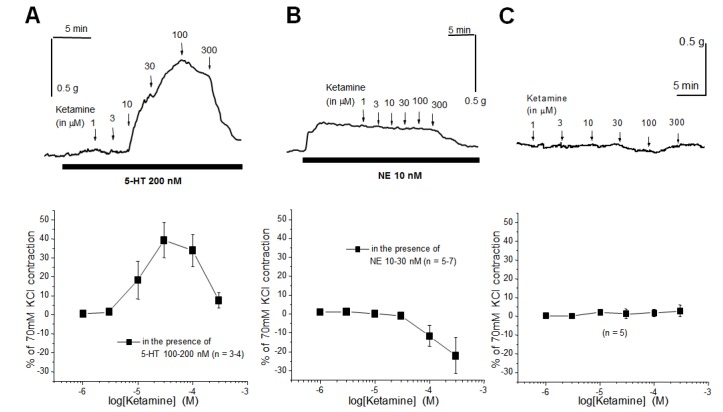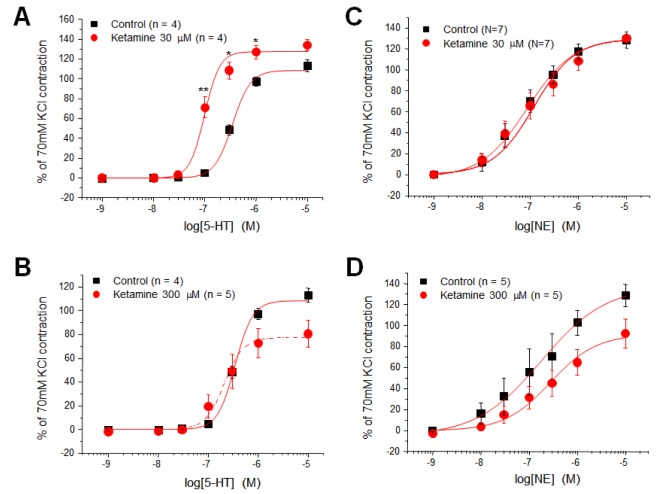1. Goodman LS, Hardman JG, Limbird LE, Gilman AG. Goodman and Gilman's the pharmacological basis of therapeutics. 10th ed. New York: McGraw-Hill;2001. p. 342–347.
2. Katzung BG. Basic & clinical pharmacology. A Concise medical library for practitioner and student. 5th ed. Los Altos, Calif: Lange Medical Publications;1982. p. 350–362.
3. White PF, Way WL, Trevor AJ. Ketamine--its pharmacology and therapeutic uses. Anesthesiology. 1982; 56:119–136. PMID:
6892475.

4. Zielmann S, Kazmaier S, Schnüll S, Weyland A. S-(+)-Ketamine and circulation. Anaesthesist. 1997; 46(Suppl 1):S43–S46. PMID:
9163278.
5. Zhang G, Cui J, Chen Y, Ma J. The relaxant effect of propofol on isolated rat intrapulmonary arteries. Korean J Physiol Pharmacol. 2014; 18:377–381. PMID:
25352756.

6. Craven R. Ketamine. Anaesthesia. 2007; 62(Suppl 1):48–53. PMID:
17937714.

7. Akata T, Izumi K, Nakashima M. Mechanisms of direct inhibitory action of ketamine on vascular smooth muscle in mesenteric resistance arteries. Anesthesiology. 2001; 95:452–462. PMID:
11506120.

8. Fukuda S, Murakawa T, Takeshita H, Toda N. Direct effects of ketamine on isolated canine cerebral and mesenteric arteries. Anesth Analg. 1983; 62:553–558. PMID:
6846876.

9. Hara Y, Chugun A, Nakaya H, Kondo H. Tonic block of the sodium and calcium currents by ketamine in isolated guinea pig ventricular myocytes. J Vet Med Sci. 1998; 60:479–483. PMID:
9592721.

10. Kanmura Y, Yoshitake J, Casteels R. Ketamine-induced relaxation in intact and skinned smooth muscles of the rabbit ear artery. Br J Pharmacol. 1989; 97:591–597. PMID:
2758233.

11. Yamazaki M, Ito Y, Kuze S, Shibuya N, Momose Y. Effects of ketamine on voltage-dependent Ca
2+ currents in single smooth muscle cells from rabbit portal vein. Pharmacology. 1992; 45:162–169. PMID:
1332085.

12. Kapur S, Seeman P. NMDA receptor antagonists ketamine and PCP have direct effects on the dopamine D(2) and serotonin 5-HT(2) receptors-implications for models of schizophrenia. Mol Psychiatry. 2002; 7:837–844. PMID:
12232776.

13. Kim HS, Park IS, Park WK. NMDA receptor antagonists enhance 5-HT2 receptor-mediated behavior, head-twitch response, in mice. Life Sci. 1998; 63:2305–2311. PMID:
9877220.

14. Winter JC, Doat M, Rabin RA. Potentiation of DOM-induced stimulus control by non-competitive NMDA antagonists: a link between the glutamatergic and serotonergic hypotheses of schizophrenia. Life Sci. 2000; 68:337–344. PMID:
11191649.
15. Watts SW. 5-HT in systemic hypertension: foe, friend or fantasy? Clin Sci (Lond). 2005; 108:399–412. PMID:
15831089.

16. Noh HJ, Bae YM, Park SH, Kim JG, Kim B, Kim YS, Kim SH, Cho SI, Woo NS. The vasodilatory effect of ketamine is independent of the N-methyl-D-aspartate receptor: lack of functional N-methyl-Daspartate receptors in rat mesenteric artery smooth muscle. Eur J Anaesthesiol. 2009; 26:676–682. PMID:
19352184.

17. Kim YH, Ahn DS, Joeng JH, Chung S. Suppression of peripheral sympathetic activity underlies protease-activated receptor 2-mediated hypotension. Korean J Physiol Pharmacol. 2014; 18:489–495. PMID:
25598663.

18. Banes AK, Watts SW. Upregulation of arterial serotonin 1B and 2B receptors in deoxycorticosterone acetate-salt hypertension. Hypertension. 2002; 39:394–398. PMID:
11882579.

19. Sung DJ, Noh HJ, Kim JG, Park SW, Kim B, Cho H, Bae YM. Serotonin contracts the rat mesenteric artery by inhibiting 4-aminopyridine-sensitive Kv channels via the 5-HT2A receptor and Src tyrosine kinase. Exp Mol Med. 2013; 45:e67. PMID:
24336234.

20. Domino EF, Zsigmond EK, Domino LE, Domino KE, Kothary SP, Domino SE. Plasma levels of ketamine and two of its metabolites in surgical patients using a gas chromatographic mass fragmentographic assay. Anesth Analg. 1982; 61:87–92. PMID:
7198883.

21. Lu R, Alioua A, Kumar Y, Kundu P, Eghbali M, Weisstaub NV, Gingrich JA, Stefani E, Toro L. c-Src tyrosine kinase, a critical component for 5-HT2A receptor-mediated contraction in rat aorta. J Physiol. 2008; 586:3855–3869. PMID:
18599541.
22. Smith JR, Kim C, Kim H, Purdy RE. Precontraction with elevated concentrations of extracellular potassium enables both 5-HT1B and 5-HT2A "silent" receptors in rabbit ear artery. J Pharmacol Exp Ther. 1999; 289:354–360. PMID:
10087024.
23. Kim SH, Bae YM, Sung DJ, Park SW, Woo NS, Kim B, Cho SI. Ketamine blocks voltage-gated K
+ channels and causes membrane depolarization in rat mesenteric artery myocytes. Pflugers Arch. 2007; 454:891–902. PMID:
17342532.
24. Bae YM, Kim A, Kim J, Park SW, Kim TK, Lee YR, Kim B, Cho SI. Serotonin depolarizes the membrane potential in rat mesenteric artery myocytes by decreasing voltage-gated K
+ currents. Biochem Biophys Res Commun. 2006; 347:468–476. PMID:
16828462.
25. Cogolludo A, Moreno L, Lodi F, Frazziano G, Cobeño L, Tamargo J, Perez-Vizcaino F. Serotonin inhibits voltage-gated K
+ currents in pulmonary artery smooth muscle cells: role of 5-HT2A receptors, caveolin-1, and KV1.5 channel internalization. Circ Res. 2006; 98:931–938. PMID:
16527989.
26. Arévalo-León LE, Gallardo-Ortíz IA, Urquiza-Marín H, Villalobos-Molina R. Evidence for the role of alpha1D- and alpha1A-adrenoceptors in contraction of the rat mesenteric artery. Vascul Pharmacol. 2003; 40:91–96. PMID:
12646397.
27. Hussain MB, Marshall I. Alpha(1)-adrenoceptor subtypes mediating contractions of the rat mesenteric artery. Eur J Pharmacol. 2000; 395:69–76. PMID:
10781676.
28. Yousif M, Kadavil EA, Oriowo MA. Heterogeneity of alpha 1-adrenoceptor subtypes mediating noradrenaline-induced contractions of the rat superior mesenteric artery. Pharmacology. 1998; 56:196–206. PMID:
9566021.
29. Lee HM, Hahn SJ, Choi BH. Blockade of Kv1.5 channels by the antidepressant drug sertraline. Korean J Physiol Pharmacol. 2016; 20:193–200. PMID:
26937216.

30. Lee HM, Hahn SJ, Choi BH. Blockade of Kv1.5 by paroxetine, an antidepressant drug. Korean J Physiol Pharmacol. 2016; 20:75–82. PMID:
26807026.







 PDF
PDF ePub
ePub Citation
Citation Print
Print



 XML Download
XML Download